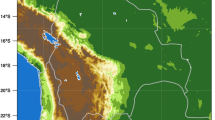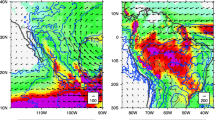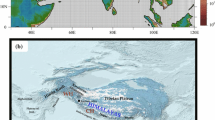Abstract
Glaciers over the central Himalaya have retreated at particularly rapid rates in recent decades, while glacier mass in the Karakoram appears stable. To address the meteorological factors associated with this contrast, 36 years of Climate Forecast System Reanalyses (CFSR) are dynamically downscaled from 1979 to 2015 with the Weather Research and Forecasting (WRF) model over High Mountain Asia at convection permitting grid spacing (6.7 km). In all seasons, CFSR shows an anti-cyclonic warming trend over the majority of High Mountain Asia, but distinctive differences are observed between the central Himalaya and Karakoram in winter and summer. In winter and summer, the central Himalaya has been under the influence of an anti-cyclonic trend, which in summer the downscaling shows has reduced cloud cover, leading to significant warming and reduced snowfall in recent years. Contrastingly, the Karakoram has been near the boundary between large-scale cyclonic and anti-cyclonic trends and has not experienced significant snowfall or temperature changes in winter or summer, despite significant trends in summer of increasing cloud cover and decreasing shortwave radiation. This downscaling does not identify any trends over glaciers in closer neighboring regions to the Karakoram (e.g., Hindu Kush and the western Himalaya) where glaciers have retreated as over the central Himalaya, indicating that there are other factors driving glacier mass balance that this downscaling is unable to capture. While this study does not fully explain the Karakoram anomaly, the identified trends detail important meteorological contributions to the observed differences between central Himalaya and Karakoram glacier evolution in recent decades.














Similar content being viewed by others
References
Archer DR, Fowler HJ (2004) Spatial and temporal variations in precipitation in the Upper Indus Basin, global teleconnections and hydrological implications. Hydrol Earth Syst Sci 8:47–61
Bao X, Zhang F (2013) Evaluation of NCEP-CFSR, NCEP-NCAR, ERA-Interim, and ERA-40 reanalysis datasets against independent sounding observations over the Tibetan Plateau. J Clim 26:206–214
Barros AP, Lang TJ (2003) Monitoring the monsoon in the Himalayas: observations in central Nepal, June 2001. Mon Weather Rev 131:1408–1427
Barros AP, Chiao S, Lang TJ, Burbank D, Putkonen J (2006) From weather to climate-seasonal and interannual variability of storms and implications for erosion processes in the Himalaya, vol 398. Geological Society of America, Special Paper, Boulder, pp 17–38
Bolch T, Kulkarni A, Kääb A, Huggel C, Paul F, Cogley JG, Frey H, Kargel JS, Fujita K, Scheel M, Bajracharya S, Stoffel M (2012) The state and fate of Himalayan glaciers. Science 336:310–314
Bollasina M, Bertolani L, Tartari G (2002) Meteorological observations at high altitude in the Khumbu Valley, Nepal Himalayas, 1994–1999. Bull Glaciol Res 19:1–11
Bookhagen B, Strecker MR (2008) Orographic barriers, high-resolution TRMM rainfall, and relief variations along the eastern Andes. Geophys Res Lett 35:L06403
Bookhagen B, Burbank DW (2010) Towards a complete Himalayan hydrological budget: the spatiotemporal distribution of snowmelt and rainfall and their impact on river discharge. J Geophys Res 115:F03019
Cannon F, Carvalho LMV, Jones C, Bookhagen B (2015) Multi-annual variations in winter westerly disturbance activity affecting the Himalaya. Clim Dyn 44:441–455
Cannon F, Carvalho LMV, Jones C, Norris J, Bookhagen B, Kiladis GN (2017) Effects of topographic smoothing on the simulation of winter precipitation in High Mountain Asia. J Geophys Res Atmos 122:1456–1474
Dee DP, Uppala SM, Simmons AJ, Berrisford P, Poli P, Kobayashi S, Andrae U, Balmaseda MA, Balsamo G, Bauer P, Bechtold P, Beljaars ACM, van de Berg L, Bidlot J, Bormann N, Delsol C, Dragani R, Fuentes M, Geer AJ, Haimberger L, Healy SB, Hersbach H, Hólm EV, Isaksen L, Kållberg P, Köhler M, Matricardi M, McNally AP, Monge-Sanz BM, Morcrette J-J, Park B-K, Peubey C, de Rosnay P, Tavolato C, Thépaut J-N, Vitart F (2011) The ERA-Interim reanalysis: configuration and performance of the data assimilation system. Q J R Meteorol Soc 137:553–597
Duan K, Yao T, Thompson LG (2006) Response of monsoon precipitation in the Himalayas to global warming. J Geophys Res 111:D19110. https://doi.org/10.1029/2006JD007084
Fowler HJ, Archer DR (2006) Conflicting signals of climate change in the Upper Indus Basin. J Clim 19:4276–4293
Forsythe N, Hardy AJ, Fowler HJ, Blenkinsop S, Kilsby CG, Archer DR, Hashmi MZ (2015) A detailed cloud fraction climatology of the Upper Indus Basin and its implications for near-surface air temperature. J Clim 28:3537–3556
Forsythe N, Fowler HJ, Li X-F, Blenkinsop S, Pritchard D (2017) Karakoram temperature and glacial melt driven by regional atmospheric circulation variability. Nat Clim Chang 7:664–670
Gardelle J, Berthier E, Arnaud Y (2012) Slight mass gain of Karakoram glaciers in the early twenty-first century. Nat Geosci 5:322–325
Gardelle J, Berthier E, Arnaud Y, Kääb A (2013) Region-wide glacier mass balances over the Pamir–Karakoram–Himalaya during 1999–2011. Cryosphere 7:1263–1286
Gao Y, Xu J, Chen D (2015) Evaluation of WRF mesoscale climate simulations over the Tibetan Plateau during 1979–2011. J Clim 28:2823–2841
Hasnain SI (2002) Himalayan glaciers meltdown: impact on South Asian rivers. In: van Lanen HAJ, Demuth S (eds) FRIEND 2002—regional hydrology: bridging the gap between research and practice, vol 274. IAHS Publication, London, pp 417–423
Hewitt K (2005) The Karakoram anomaly? Glacier expansion and the “elevation effect”, Karakoram Himalaya. Mt Res Dev 25:332–340
Hong S-Y, Noh Y, Dudhia J (2006) A new vertical diffusion package with an explicit treatment of entrainment processes. Mon Weather Rev 134:2318–2341
Houze RA Jr, Wilton DC, Smull BF (2007) Monsoon convection in the Himalayan region as seen by the TRMM precipitation radar. Q J R Meteorol Soc 133:1389–1411
Iacono MJ, Delamere JS, Mlawer EJ, Shephard MW, Cloud SA, Collins WD (2008) Radiative forcing by long-lived greenhouse gases: calculations with the AER radiative transfer models. J Geophys Res 113:D13103
Kääb A, Berthier E, Nuth C, Gardelle J, Arnaud Y (2012) Contrasting patterns of early twenty-first-century glacier mass change in the Himalayas. Nature 488:495–498
Kääb A, Treichler D, Nuth C, Berthier E (2015) Brief communication: contending estimates of 2003–2008 glacier mass balance over the Pamir–Karakoram–Himalaya. Cryosphere 9:557–564
Kain JS (2004) The Kain–Fritsch convective parameterization: an update. J Appl Meteorol 43:170–181
Krishnan R, Sabin TP, Ayantika DC, Kitoh A, Sugi M, Murakami H, Turner AG, Slingo JM, Rajendran K (2013) Will the South Asian monsoon overturning circulation stabilize any further? Clim Dyn 40:187–211
Lang TJ, Barros AP (2004) Winter storms in the Central Himalayas. J Meteor Soc Jpn 82:829–844
Liu C, Ikeda K, Thompson G, Rasmussen RM, Dudhia J (2011) High-resolution simulations of wintertime precipitation in the Colorado Headwaters region: sensitivity to physics parameterizations. Mon Weather Rev 139:3533–3553
Medina S, Houze RA Jr, Kumar A, Niyogi D (2010) Summer monsoon convection in the Himalayan region: terrain and land cover effects. Q J R Meteorol Soc 136:593–616
Malik N, Bookhagen B, Mucha PJ (2016) Spatiotemporal patterns and trends of Indian monsoonal rainfall extremes. Geophys Res Lett 43:1710–1717
Mölg T, Maussion F, Collier E, Chiang JCH, Scherer D (2017) Prominent midlatitude circulation signature in High Asia’s surface climate during monsoon. J Geophys Res Atmos 122:12,702–12,712
Monin AS, Obukhov AM (1954) Basic laws of turbulent mixing in the surface layer of the atmosphere. Tr Akad Nauk SSSR Geofiz Inst 24(151):163–187
Niu G-Y, Yang Z-L, Mitchell KE, Chen F, Ek MB, Barlage M, Kumar A, Manning K, Niyogi D, Rosero E, Tewari M, Xia Y (2011) The community Noah land surface model with multiparameterization options (NoahMP): 1. Model description and evaluation with localscale measurements. J Geophys Res 116:D12109
Norris J, Carvalho LMV, Jones C, Cannon F (2015) WRF simulations of two extreme snowfall events associated with contrasting extratropical cyclones over the western and central Himalaya. J Geophys Res 120:3114–3138
Norris J, Carvalho LMV, Jones C, Cannon F, Bookhagen B, Palazzi E, Tahir AA (2017) The spatiotemporal variability of precipitation over the Himalaya: evaluation of one-year WRF model simulation. Clim Dyn 49:2179–2204
Rango A, Martinec J (1995) Revisisting the degreeday method for snowmelt computations. Water Resour Bull 31(4):657–669
Roxy MK, Ritika K, Terray P, Murtugudde R, Ashok K, Goswami BN (2015) Drying of Indian subcontinent by rapid Indian Ocean warming and a weakening land–sea thermal gradient. Nat Commun 6:7423. https://doi.org/10.1038/ncomms8423
Saha S, Moorthi S, Pan H-L, Wu X, Wang J, Nadiga S, Tripp P, Kistler R, Woollen J, Behringer D, Liu H, Stokes D, Grumbine R, Gayno G, Wang J, Hou Y-T, Chuang H-Y, Juang H-MH, Sela J, Iredell M, Treadon R, Kleist D, Van Delst P, Keyser D, Derber J, Ek M, Meng J, Wei H, Yang R, Lord S, van den Dool H, Kumar A, Wang W, Long C, Chelliah M, Xue Y, Huang B, Schemm J-K, Ebisuzaki W, Lin R, Xie P, Chen M, Zhou S, Higgins W, Zou C-Z, Liu Q, Chen Y, Han Y, Cucurull L, Reynolds RW, Rutledge G, Goldberg M (2010) The NCEP climate forecast system reanalysis. Bull Am Meteorol Soc. 1015–1057https://doi.org/10.1175/2010BAMS3001.1
Scherler D, Bookhagen B, Strecker MR (2011) Spatially variable response of Himalayan glaciers to climate change affected by debris cover. Nat Geosci 4:156–159
Shrestha AB, Wake CP, Mayewski PA, Dibb JE (1999) Maximum temperature trends in the Himalaya and its vicinity: an analysis based on temperature records from Nepal for the period 1971–94. J Clim 12:2775–2786
Skamarock WC, Klemp JB, Dudhia J, Gill DO, Barker DM, Duda MG, Huang X-Y, Wang W, Powers JG (2008) A description of the advanced research WRF version 3. NCAR Technical Note NCAR/TN–475+STR. NCAR, Boulder
Stauffer DR, Seaman NL (1990) Use of four-dimensional data assimilation in a limited-area mesoscale model. Part I: experiments with synoptic-scale data. Mon Weather Rev 118:1250–1277
Stauffer DR, Seaman NL, Binkowski FS (1991) Use of four-dimensional data assimilation in a limited-area mesoscale model. Part II: effects of data assimilation within the planetary boundary layer. Mon Weather Rev 119:734–754
Tahir AA, Chevallier P, Arnaud Y, Ahmad B (2011) Snow cover dynamics and hydrological regime of the Hunza River basin, Karakoram Range, Northern Pakistan. Hydrol Earth Syst Sci 15:2275–2290
Thompson G, Field PR, Rasmussen RM, Hall WD (2008) Explicit forecasts of winter precipitation using an improved bulk microphysics scheme. Part II: implementation of a new snow parameterization. Mon Weather Rev 136:5095–5115
Thompson G, Tewari M, Ikeda K, Tessendorf S, Weeks C, Otkin J, Kong F (2016) Explicitly-coupled cloud physics and radiation parameterizations and subsequent evaluation in WRF high-resolution convective forecasts. Atmos Res 168:92–104
Wang B, Bao Q, Hoskins B, Wu G, Liu Y (2008) Tibetan Plateau warming and precipitation changes in East Asia. Geophys Res Lett 35:L14702. https://doi.org/10.1029/2008GL034330
Wang B, Long CN, Leung LR, Dudhia J, McFarlane SA, Mather JH, Ghan SJ, Liu X (2009) Evaluating regional cloud-permitting simulations of the WRF model for the Tropical Warm Pool International Cloud Experiment (TWP-ICE), Darwin, 2006, J Geophys Res 114:D21203. https://doi.org/10.1029/2009JD012729
Wilks DS (2006) Statistical methods in the atmospheric sciences. Elsevier, Burlington
Yamada T, Shiraiwa T, Iida H, Kadota T, Watanabe T, Rana B, Ageta Y, Fushimi H (1992) Fluctuations of the glaciers from the 1970s to 1989 in the Khumbu, Shorong and Langtang regions, Nepal Himalayas. Bull Glacier Res 10:11–19
Yasutomi N, Hamada A, Yatagai A (2011) Development of a long-term daily gridded temperature dataset and its application to rain/snow discrimination of daily precipitation. Glob Environ Res V15N2:165–172
Yatagai A, Kamiguchi K, Arakawa O, Hamada A, Yasutomi N, Kitoh A (2012) APHRODITE: constructing a long-term daily gridded precipitation dataset for Asia based on a dense network of rain gauges. Bull Am Meteorol Soc. https://doi.org/10.1175/BAMS-D-11-00122.1
Zhao Y, Huang A, Zhou Y, Huang D, Yeng Q, Ma Y, Li M, Wei G (2014) Impact of the middle and upper tropospheric cooling over Central Asia on the summer rainfall in the Tarim Basin, China. J Clim 27:4721–4732
Acknowledgements
This research was supported by the Climate and Large-scale Dynamics Program, from the National Science Foundation (NSF award-AGS 1116105) and by the U.S. National Aeronautics and Space Administration (NASA) Headquarters under the NASA Earth and Space Science Fellowship Program (Grant no. 13-EARTH13F-26). The CFSR data used in this research were developed by NCEP and provided by NCAR, available at http://rda.ucar.edu/pub/cfsr.html. ERA-Interim data were developed by ECMWF and made available through NCAR (https://rda.ucar.edu/datasets/ds627.2/). In-situ precipitation and temperature data were provided by PMD and WAPDA. MODIS data were obtained from http://modis-atmos.gsfc.nasa.gov/MOD06_L2. High-performance computing support from Yellowstone (ark:/85065/d7wd3xhc) was provided by NCAR’s Computational and Information Systems Laboratory (CISL), sponsored by the NSF. Thanks to the anonymous reviewers whose comments have greatly improved this manuscript.
Author information
Authors and Affiliations
Corresponding author
Rights and permissions
About this article
Cite this article
Norris, J., Carvalho, L.M.V., Jones, C. et al. Deciphering the contrasting climatic trends between the central Himalaya and Karakoram with 36 years of WRF simulations. Clim Dyn 52, 159–180 (2019). https://doi.org/10.1007/s00382-018-4133-3
Received:
Accepted:
Published:
Issue Date:
DOI: https://doi.org/10.1007/s00382-018-4133-3




